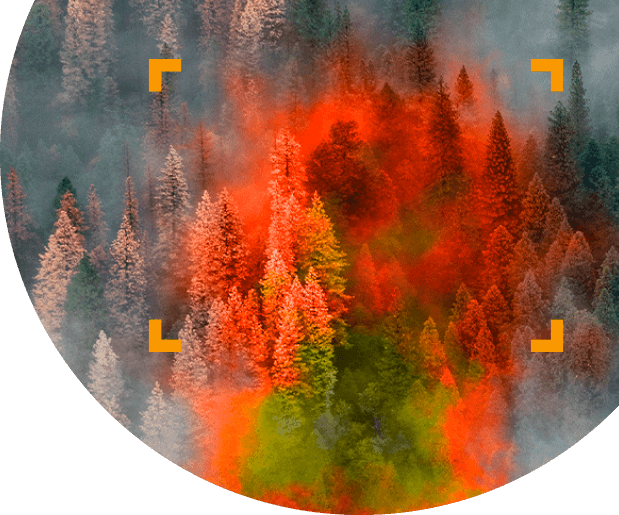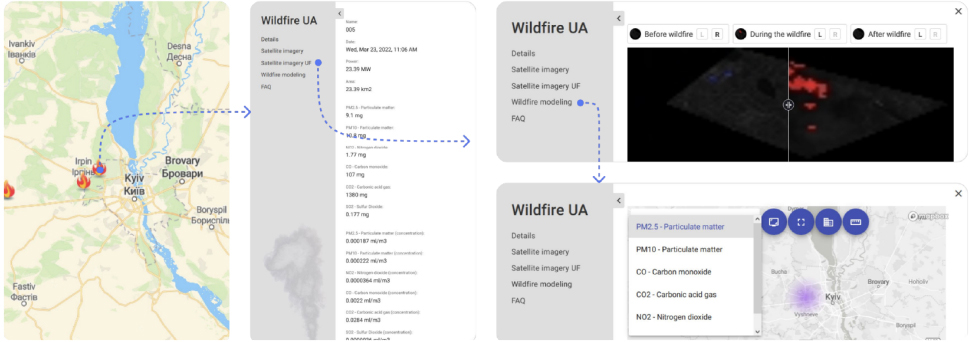
After the onset of the full-scale war in Ukraine on February 24, 2022, our team of scientists, shaken by the shock, immediately began seeking ways in which we could provide assistance and be of value. By March, the issue of radiation safety had become a pressing concern, as the adversary engaged in alarming provocations, occupying the Chernobyl Exclusion Zone and shelling the territories around the Chornobyl and Zaporizhzhia Nuclear Power Plants.
We swiftly pivoted our focus to developing both a module for visualizing the direction of airflows and a simulation of potential emissions in case of damage to one of the reactors at Chornobyl and Zaporizhzhia. Additionally, we worked on creating a service for tracking radiation levels in Ukraine and Europe. For a more detailed account of this, please refer to the Case Study - Modeling of NPP Accident Damage.
Another critical task was to assist government agencies in monitoring and environmental departments in analyzing and forecasting forest fires. This encompassed forecasting fire spread and the dispersion of hazardous by-products, including solid particles like PM2.5 and PM10, as well as gases such as O3 (ozone), NO2 (nitrogen dioxide), SO₂ (sulfur dioxide), and CO (carbon monoxide).

The lack of accurate and on-time data on fires makes it challenging to address this problem affectively
Prognostic analysis of fires
Air impact assessment

Our mission was clear: to develop a comprehensive system capable of monitoring, analyzing, and predicting regional air pollution resulting from landscape fires in Ukraine.
This marked the inception of our journey towards creating a monitoring and analysis system for forest fires in Ukraine.
WildFiresUA is our solution—a system designed for the analysis and prediction of regional air pollution caused by gases and aerosols from landscape fires in Ukraine, commencing from February 24, 2022.
WildFiresUA is designed to allow the State Emergency Service of Ukraine (SESU), environmental agencies, and the public to visualize the analysis of air pollution following large-scale fires, mainly forest and field fires. We are also working on a real-time analysis service. It will help understand the dispersion of polluted air and its potential consequences for people.
It's crucial to comprehend that large-scale fires pose a significant threat to human life and health, even in regions distant from the fire zone, as smoke can spread over tens of kilometers and beyond. Using satellite data, we identify the ignition point, analyze the fire's extent, and process all data about a specific fire, including weather conditions and wind direction, to accurately model the emissions' spread.

Wildfires

Fire detection

Measurement of pollution levels by ground stations

Meteorological forecasting and modeling dispersionatmospheric pollution

Visualization of the forecast pollution on the map

Users notification

The system displays fires detected using satellites with varying levels of detail. On the interactive map, we provide information about specific fires, including temperature, emissions quantities (PM2.5, PM10, CO, CO2, NO2, SO2), coordinates, and area in square kilometers. We also classify emissions by types and show their concentration over specific time periods.
Scientifically oriented startup YourAirTest, with the support of partners, contributed to the development of a fuel map for the entire Ukraine using satellite imagery. This map, created using high-resolution optical and infrared data from multiple satellite platforms, offers detailed information about the types and quantities of fuel available in different regions of the country based on the Fuel Characteristic Classification System (FCCS) standards.
By utilizing the fuel map, we were able to assess emissions of various air pollutants resulting from fires in Ukraine due to the war.
We have previously fine-tuned our WRF-YAT Meteo model (a numerical weather prediction model) and integrated it with CALPUFF (a multi-layer dispersion model with an integrated Lagrangian modeling system) for simulating emissions' dispersion, particularly from fires.
The challenges during the development of WildfiresUA were associated with the need to accurately detect fires and assess their size. We experimented with methods such as thermal anomalies and satellite imagery, but satisfactory results eluded us until we employed Sentinel and MODIS satellite imagery.
The Copernicus Sentinel mission, comprising two satellites with a 180° phase difference, played a pivotal role. It allowed us to monitor Earth's surface state over a wide swath (290 km) with extended revisit periods, facilitating continuous monitoring of affected areas. Consequently, our system depicts the condition of these regions before, during, and after forest fires.

WildFiresUA is a valuable solution that provides critical analysis and forecasting of regional air pollution caused by gases and aerosols from landscape fires in Ukraine, starting from February 24, 2022.
For our users, WildfiresUA offers a user-friendly interface.
To achieve this goal, we have developed seven core directions for our development
WildFiresUA is not just a technological solution; it is an important tool to help protect human health and the environment in the face of devastating forest fires, especially during war conflicts